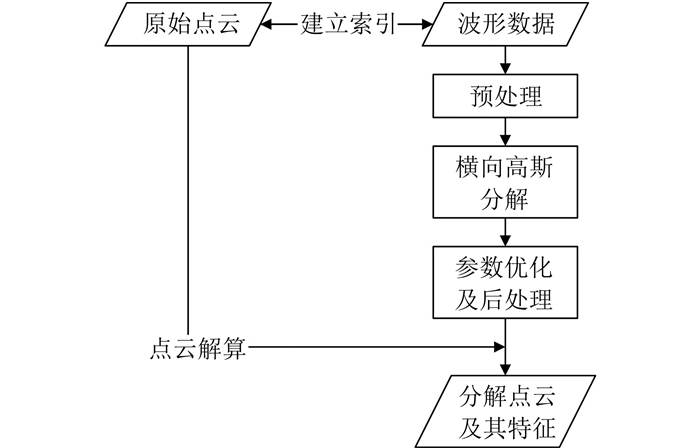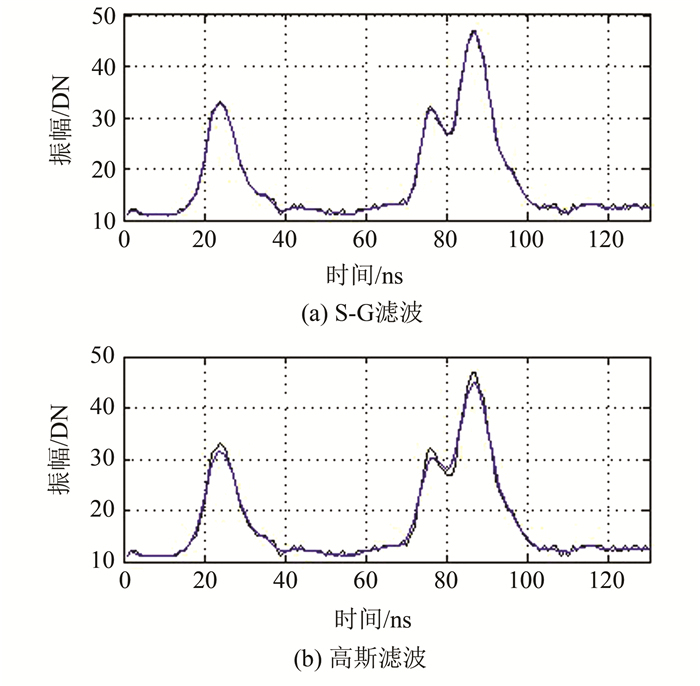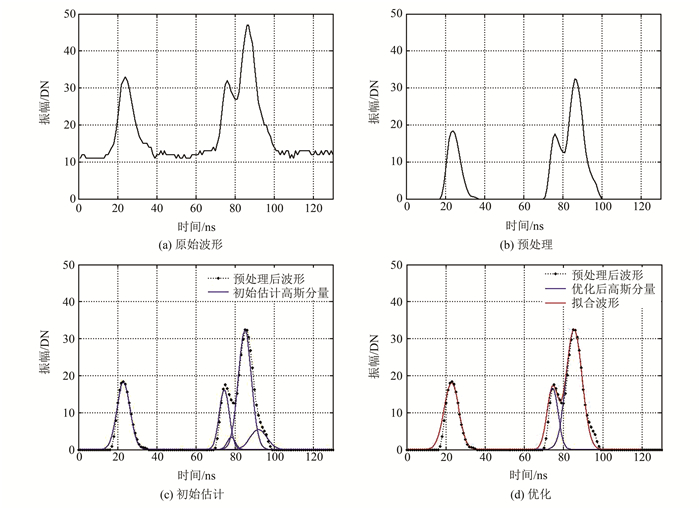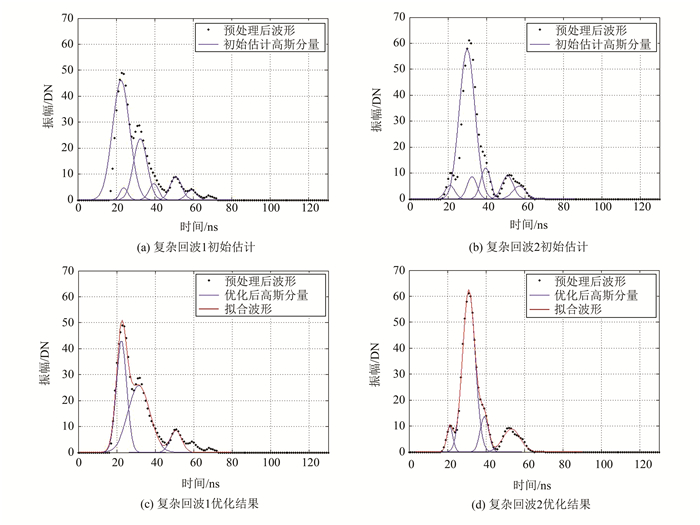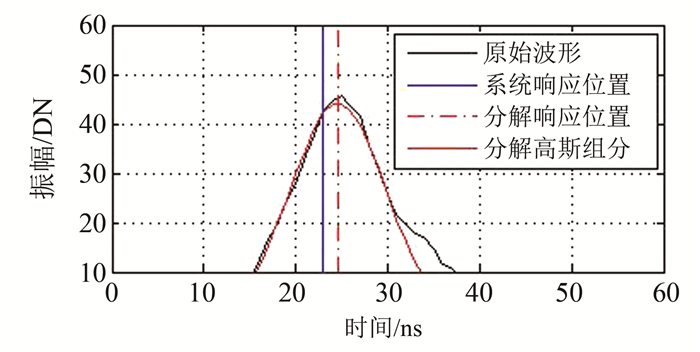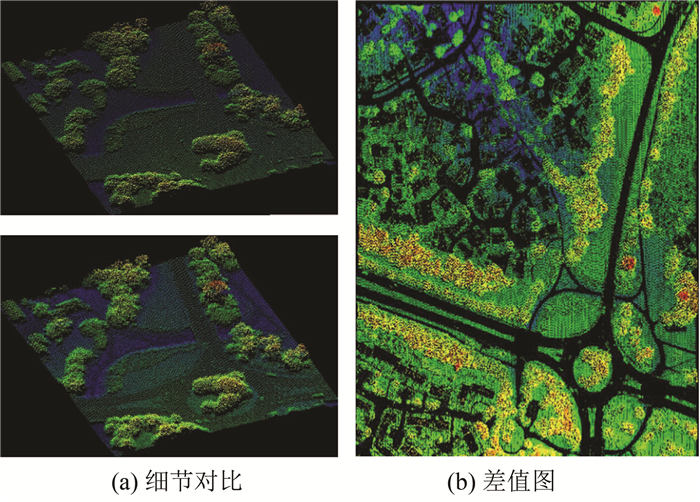-
摘要: 针对机载激光雷达波形数据分解易受噪声影响,高斯组分个数及叠加波初始参数估计不精确等问题,提出了一种横向高斯波形分解方法。该方法首先对波形进行滤波平滑处理,剔除背景噪声后,将检测到的波峰划分为不同的类型,分别估计其初始参数;然后横向逐步迭代分解估计初始高斯分量,在去除无效的初始高斯分量后,利用列文伯格-马夸尔特(Levenberg-Marquardt)算法进一步优化参数;最后解算得到分解点云。实验结果表明,该方法能有效地检测各种类型的回波信号,对叠加波形具有良好的适应性,并能在一定程度上保护弱波。相比系统点云,本文方法解算的点云在数量和细节上更具有优势,反映了更加丰富的地物垂直结构信息以及在森林参数获取方面的应用潜力。
-
关键词:
- 全波形数据 /
- 高斯分解 /
- 列文伯格-马夸尔特算法 /
- 分解点云
Abstract: The decomposition of waveform data is a key step in waveform analysis. Traditional wave-form decomposition methods cannot detect overlapped sub-waveforms and weak sub-waveforms, and cannot appropriately estimate the number of Gaussian components. In this article, we propose a lateral Gaussian decomposition method. A waveform is smoothed after removing the background noise. We divide the detected waves into different types of waveforms, and estimate their initial parameters with different methods, then progressively laterally decompose waveform until all the Gaussian components are decided. After removing invalid components, we usethe Levenberg-Marquardt method to further optimize the parameters. Experiments show that this new method can effectively detect different kinds of complicated waveforms; demonstrating both robustness and efficiency.-
Keywords:
- full-waveform /
- Gaussian decomposition /
- LM method /
- generate point cloud
-
雾霾是空气污染和气象因素共同作用的结果。大气中的微颗粒物(PM2.5/PM10)是导致能见度降低的主要因素[1],城市大气PM2.5/PM10污染影响空气质量,威胁人群健康,是具有区域性特征、危害严重的大气污染物。Fang[2]以美国东北部为例研究了夏季PM2.5空气质量的物理气候模型; Boynard[3]利用红外大气探测干涉仪 (Infrared Atomospheric Sounding Interferometer,IASI)卫星测量技术探测了中国华北地区的冬季空气污染。近年来,我国部分学者针对北京、广州、深圳和天津等城市开展了城市PM2.5浓度特征及其影响因素的分析研究[4-9]。
水汽(可降水量)是影响天气变化的关键要素,也是雾霾天气形成的外在影响因素之一,国内众多学者开展了GPS水汽的应用研究[10, 11]。研究发现,GPS可降水量在雾霾过程前后有较大的变化[12]。据此可以推测,水汽的变化可能会影响大气中PM2.5/PM10的质量浓度变化。本文利用2013年北京市天坛站的PM2.5/PM10观测资料,结合GPS水汽资料、无线电探空水汽资料,进行北京地表PM2.5/PM10变化与大气水汽变化的相关性研究,并对相关性结果进行分析。
1 实验数据与方法
本文研究数据主要包含GPS水汽(precipitable water vapor,PWV),无线电探空水汽(整层水汽和分层水汽)以及PM2.5/PM10浓度观测数据3类数据。
1) GPS水汽
国际GNSS服务(Internatianal GNSS Service,IGS)提供国际GPS站点的对流层延迟解算资料和气象观测数据,通过下载BJNM站点的对流层延迟和气象资料,依据GPS气象学原理可计算获得时值GPS水汽序列,单位为mm。但由于IGS提供的GPS对流层延迟数据和气象数据不完整,导致解算的GPS水汽序列不连续,有个别天数数据缺失。
2) 无线电探空水汽
无线电探空是气象领域探测水汽的一种常用手段,利用该方法可探测各层气压、高度、温度、风速和风向等要素,利用各分界层的气压和温度观测数据可反演各层的水汽和整层水汽。无线电探空在每天的8:00和20:00(北京时间)进行观测。本文收集了北京市2013年无线电探空观测资料,按照李国平[13]提供的无线电探空水汽计算方法,获得无线电探空整层水汽和分层水汽,单位为mm。
3) PM2.5/PM10浓度
北京有多个PM2.5/PM10浓度观测站点,本文选择与BJNM站点最为接近的天坛站点,该站点资料为时值观测数据。北京天坛站2013年的PM2.5/PM10观测资料缺失9月和10月上旬数据,其他时间也有个别天数不连续。PM2.5/PM10观测数据的单位为μg/m3。
BJNM站点GPS PWV与天坛站PM2.5/PM10观测资料均为时值观测数据,因此本文的相关性分析均是时值数据比较;无线电探空观测站点每天观测两个时次,无线电探空水汽用于分析分层水汽与PM2.5/PM10观测的相关性,两者相关性的计算对应每日8时和20时的两个频次。
2 GPS PWV变化与PM2.5/PM10变化的比较
由于北京处在大陆干冷气团向东南移动的通道上,每年从10月到次年5月受来自西伯利亚的干冷气团控制,6~9月前后受到海洋暖湿气团的影响。降水主要集中在夏季,7、8月尤为集中。由于夏季与其他季节气候状态明显不同,因此本文将GPS PWV与PM2.5/PM10的比较分为夏季和秋、冬、春季节两个时段进行。
2.1 夏季GPS PWV与PM2.5/PM10的比较
6~8月为北京的夏季,降水对大气中的雾霾起到了清除和冲刷作用。对于夏季水汽与PM2.5/PM10的相关性,将选择无降水过程时段进行比较。根据天气网(http://lishi.tianqi.com)提供的北京历史天气查询,2013年6~8月北京发生的降水日数分别为15天、16天和11天,选择该时段持续时间3日或以上的时间段进行PM2.5/PM10变化和GPS PWV变化的比较(图 1为其中3个时段两者变化的比较),统计了夏季5个时段的GPS PWV与PM2.5/PM10的相关性(表 1)。
表 1 夏季GPS PWV与PM2.5/PM10的相关性Table 1. Correlation Between GPS PWV and PM2.5/PM10 in Summer时间 PM2.5 & GPS PWV PM10 & GPS PWV 161~165 0.228 0.298 168~173 0.057 -0.043 224~226 0.392 0.275 229~231 -0.054 -0.325 233~237 0.612 0.339 通过图 1中 GPS PWV与PM2.5/PM10的变化比较,结合表 1的相关性统计结果,可以看出,GPS PWV变化与PM2.5/PM10变化在夏季没有明显相关性。相比其他季节,夏季雾霾发生的频率低一些,这是因为夏季经常有强对流天气发生,降水对大气中的雾霾能起到清除和冲刷作用。降水过程有助于PM2.5/PM10的质量浓度下降。强对流天气创造了大气污染物扩散的有利条件,一般不易形成大范围的雾霾天气。
2.2 秋、冬、春季节GPS PWV与PM2.5/PM10的比较
图 2(a)~2(c)为秋、冬、春季节北京GPS PWV与PM2.5/PM10的比较,表 2对期间多个时段两者的相关性进行了统计分析。
表 2 秋、冬、春季节GPS PWV与PM2.5/PM10的相关性Table 2. Correlation Between GPS PWV and PM2.5/PM10 Among Autumn,Winter and Spring季节 年积日 PM2.5 & GPS PWV PM10 & GPS PWV 058~063 0.739 0.417 春节 069~072 0.663 0.619 122~125 0.501 0.536 295~297 0.512 - 300~305 0.739 0.794 秋季 307~310 0.646 0.639 311~313 0.890 0.796 326~331 0.601 0.604 339~343 0.711 0.799 冬季 022~026 0.663 0.560 046~048 0.642 0.614 052~054 0.639 0.811 由图 2和表 2可看出,在秋、冬、春季节,GPS PWV变化与PM2.5/PM10变化的相关系数大于0.5。水汽的上升对应了PM2.5/PM10质量浓度的上升,原因分析如下。
1) 水汽的增加能促进二氧化硫、氮氧化物被氧化成二次污染物颗粒,使PM2.5/PM10浓度提高;
2) 当水汽上升时,臭氧与有机物发生化学反应生成大量的微颗粒,而该微颗粒属于PM2.5/PM10;
3) 北京PM2.5/PM10污染源的组成中,煤燃烧所占比重最大,尤其是到了冬季,燃煤供暖,煤燃烧占的比重会更大。燃煤PM2.5/PM10微粒大多为难溶于水且吸湿性较差的球形硅铝质矿物颗粒,润湿性较差,因而PM2.5/PM10颗粒不因水汽的增加而减少。
3 秋、冬、春季节无线电探空水汽变化PM2.5/PM10变化的比较
由§2的研究可知,秋、冬、春季节GPS PWV(整层水汽含量)与PM2.5/PM10的变化的相关系数大于0.5。本节将开展无线电探空分层水汽变化与PM2.5/PM10变化的比较研究。
利用无线电探空仪探测的各分界层的气压和温度观测数据可用于反演各层的水汽和整层水汽值。各分界层以气压为标准进行划分(高度为平均值),共11层:第一层PWV(1),范围为地面~1000 hPa (约0~250 m);第二层PWV(2),范围为1000 ~925 hPa (约250~850 m);第三层PWV(3),范围为925 ~850 hPa(约850~1 500 m);第四层PWV(4),范围为850 ~700 hPa(约1 500~3 000 m);第五层PWV(5),范围为700 ~500 hPa(约3 000~5 500 m);第六层PWV(6),范围为500 ~400 hPa(约5 500~7 000 m);第七层PWV(7),范围为400~300 hPa (约7 000~9 000 m);第八层PWV(8),范围为300~250 hPa(约9 000~10 200 m);第九层PWV(9),范围为250~200 hPa (约10 200~11 500 m);第十层PWV(10),范围为200~150 hPa(约11 500~13 500 m);第十一层PWV(11),范围为150~100 hPa(约13 500~16 000 m)。
本文进行了北京市2013年的无线电探空整层水汽和分层水汽的计算,获得了全年的无线电探空水汽序列。按照季节绘制无线电探空分层水汽的垂直廓线图(图 3),并计算各季节分层水汽占整层水汽的比重(表 3)。
表 3 不同季节水汽的垂直廓线Table 3. Percent of per Layer PWV in Different Seasons无线电探空分层 春季 夏季 秋季 冬季 1 0.033 0.011 0.043 0.060 2 0.222 0.215 0.221 0.187 3 0.192 0.185 0.191 0.174 4 0.290 0.281 0.281 0.290 5 0.205 0.220 0.203 0.220 6 0.039 0.054 0.041 0.040 7 0.014 0.025 0.015 0.015 8 0.002 0.005 0.002 0.003 9 0.001 0.002 0.001 0.003 10 0.001 0.001 0.001 0.004 11 0.001 0.001 0.001 0.004 由图 3和表 3可知,无线电探空第2~5层的水汽占整层水汽的比重最大,由于篇幅的限制,图 4~6仅绘制了无线电探空整层水汽、第3层水汽和第4层水汽与PM2.5/PM10的比较结果。由于无线电探空第8~11层水汽占整层水汽的比重不到1%,因此在本研究中不予考虑。表 4对5个时间段的无线电探空水汽(整层水汽、分层水汽)与PM2.5/PM10的相关性进行了统计分析。
表 4 无线电探空整层/分层水汽与PM2.5/PM10的相关性统计Table 4. Corelation Between Radiosonde Total/per Layer PWV and PM2.5/PM10探空水汽 024~040 043~059 061~072 319~334 339~349 PM2.5 PM10 PM2.5 PM10 PM2.5 PM10 PM2.5 PM10 PM2.5 PM10 PWV 0.703 0 0.751 5 0.626 7 0.612 7 0.602 3 0.699 6 0.551 0 0.539 3 0.592 1 0.720 3 PWV(1) -0.199 3 -0.155 8 -0.285 4 -0.238 4 -0.528 7 -0.582 7 0.407 7 0.124 8 0.033 5 0.263 5 PWV(2) 0.534 4 0.468 2 0.413 8 0.402 3 0.638 5 0.693 3 0.357 8 0.356 2 0.356 0 0.461 9 PWV(3) 0.868 2 0.843 7 0.603 6 0.599 9 0.649 0 0.723 9 0.485 9 0.516 1 0.570 1 0.608 4 PWV(4) 0.773 7 0.829 9 0.700 0 0.683 6 0.534 1 0.614 9 0.582 7 0.585 4 0.576 8 0.721 9 PWV(5) 0.405 6 0.514 5 0.564 9 0.549 6 0.359 4 0.466 4 0.608 7 0.584 5 0.671 0 0.801 8 PWV(6) 0.030 5 0.031 3 0.302 2 0.259 5 0.287 0 0.394 9 0.585 1 0.561 7 0.622 4 0.672 6 PWV(7) -0.217 6 -0.233 9 0.006 8 -0.035 2 0.265 7 0.358 6 0.685 2 0.651 5 0.396 9 0.488 2 由图 4~6和表 4看出,在秋、冬、春季节,无线电探空总水汽变化与PM2.5/PM10变化的相关性大于0.5。分层水汽与PM2.5/PM10比较中,第3、4层水汽变化与PM2.5/PM10变化最为吻合,此两层水汽的上升或者下降,对应了PM2.5/PM10观测值的上升或者下降。
4 结 语
本文利用GPS PWV、无线电探空水汽与PM2.5/PM10观测资料,进行了北京地表PM2.5/PM10变化与大气水汽变化的相关性研究,研究表明,夏季GPS PWV变化与PM2.5/PM10变化没有明显的相关性规律;在秋、冬、春季节,GPS PWV变化与PM2.5/PM10变化的相关系数大于0.5;秋、冬、春季节无线电探空整层(分层)水汽与PM2.5/PM10变化的比较中,整层水汽变化与PM2.5/PM10变化的相关系数大于0.5,第3,4层水汽变化与PM2.5/PM10变化的相关性最佳。
本文研究结果表明,在秋、冬、春季节水汽变化与PM2.5/PM10变化的相关性超过0.5,因而可以将水汽资料用于雾霾高发季节的大气微颗粒污染浓度变化的监测。
-
表 1 分解点云与系统点云坐标精度对比
Table 1 Coordinate Error Between Decomposition Point and System Record Point
点号 系统点坐标/m 分解点坐标/m 坐标差/m 距离差/m X=483 233.673 X=483 233.642 0.031 1 Y=240 462.434 Y=240 462.451 -0.017 0.225 Z=86.026 Z=85.772 0.254 X=483 234.766 X=483 234.744 0.022 2 Y=240 461.359 Y=240 461.371 -0.012 0.179 Z=85.902 Z=85.723 0.179 X=483 245.717 X=483 245.697 0.020 3 Y=240 450.802 Y=240 450.811 -0.009 0.169 Z=88.426 Z=88.257 0.169 X=483 248.772 X=483 248.734 0.038 4 Y=240 447.607 Y=240 447.626 -0.019 0.334 Z=84.380 Z=84.042 0.338 表 2 分解点云与系统点云按回波次数统计
Table 2 Comparison of Points Derived from Decomposition and the Hardware System
回波次数 分解点数 系统点数 差异 1 152 299 356 507 -204 208 2 381 256 34 170 347 086 3 74 472 1 275 73 197 4 20 924 20 20 904 5 4 485 0 4 485 6 606 0 606 7 77 0 77 8 8 0 8 总和 634 127 391 927 242 200 -
[1] Baltsavias E P. Airborne Laser Scanning:Basic Relations and Formulas[J]. ISPRS Journal of Photogrammetry & Remote Sensing, 1999, 54(2-3):199-214 https://www.sciencedirect.com/science/article/pii/S0924271699000155
[2] Mallet C, Bretar F. Full-waveform Topographic Lidar:State-of-the-art[J]. ISPRS Journal of Photogrammetry & Remote Sensing, 2009, 64(1):1-16 https://www.sciencedirect.com/science/article/pii/S0924271608000993
[3] Hug C, Ullrich A, Grimm A. Litemapper 5600 a Waveform-digitizing Lidar Terrain and Vegetation Mapping System[J]. International Archives of Photogrammetry, Remote Sensing and Spatial Information Science, 2004, 36(8/W2):24-29 https://www.researchgate.net/publication/228809808_LiteMapper-5600_-_a_waveform-digitizing_LIDAR_terrain_and_vegetation_mapping_system
[4] Wagner W, Ullrich A, Melzer T, et al. from Single-pulse to Full-waveform Airborne Laser Scanners:Potential and Practical Challenges[J]. International Archives of Photogrammetry, Remote Sensing and Spatial Information Science, 2004, 35(B3):201-206 http://citeseerx.ist.psu.edu/viewdoc/summary?doi=10.1.1.184.3393
[5] Roncat A, Wagner W, Melzer T, et al. Echo Detection and Localization in Full-waveform Airborne Laser Scanner Data Using the Averaged Square Difference Function Estimator[J]. The Photogrammetric Journal of Finland, 2008, 21(1):62-75 https://www.researchgate.net/profile/Andreas_Roncat/publication/248359607_Echo_Detection_and_Localization_in_Full-Waveform_Airborne_Laser_Scanner_Data_using_the_Averaged_Square_Difference_Function_Estimator/links/02e7e526a712b4ded6000000.pdf?inViewer=0&pdfJsDownload=0&origin=publication_detail
[6] Wagner W, Ullrich A, Ducic V, et al. Gaussian Decomposition and Calibration of a Novel Small-footprint Full-waveform Digitizing Airborne Laser Scanner[J]. ISPRS Journal of Photogrammetry & Remote Sensing, 2006, 60(2):100-112 http://www.doc88.com/p-630428910556.html
[7] Jutzi B, Stilla U. Range Determination with Waveform Recording Laser Systems Using a Wiener Filter[J]. ISPRS Journal of Photogrammetry & Remote Sensing, 2006, 61(2):95-107 https://www.researchgate.net/publication/222335624_Range_determination_with_waveform_recording_laser_systems_using_a_Wiener_Filter
[8] Malgorzata S. Decomposition Techniques for Full-waveform Airborne Laser Scanning Data[J]. Geomatics and Environmental Engineering, 2014, 8(1):61-74 doi: 10.7494/geom.2014.8.1.61
[9] Hofton M, Minster J, Blair J. Decomposition of Laser Altimeter Waveforms[J]. IEEE Transactions on Geoscience and Remote Sensing, 2000, 38(4):1989-1996 doi: 10.1109/36.851780
[10] Chauve A, Mallet C, Bretar F, et al. Processing full-waveform Lidar Data:Modelling Raw Signals[J]. International Archives of Photogrammetry, Remote Sensing and Spatial Information Sciences, 2007, 36(Part 3/W52), 102-107 https://hal-lirmm.ccsd.cnrs.fr/lirmm-00293129/document
[11] Zhu J F, Zhang Z X, Hu X Y, et al. Analysis and Application of Lidar Waveform Data Using a Progressive Waveform Decomposition Method[J]. International Archives of the Photogrammetry, Remote Sensing and Spatial Information Sciences, 2012, 38(part 531/W12), 31-36 https://www.researchgate.net/publication/274674485_Analysis_and_application_of_LiDAR_waveform_data_using_a_progressive_waveform_decomposition_method/fulltext/57a806a808ae455e854700bc/274674485_Analysis_and_application_of_LiDAR_waveform_data_using_a_progressive_waveform_decomposition_method.pdf?origin=publication_detail
[12] Yu C L, Mills J P, Voysey S. Rigorous Pulse Detection from Full-waveform Airborne Laser Scan-ning Data[J]. International Journal of Remote Sensing, 2010, 31(5):1303-1324 doi: 10.1080/01431160903380599
[13] 刘诏, 张爱武, 段已好, 等.全波形机载激光数据分解研究[J].高技术通讯, 2014, 24(2):144-151 http://www.cqvip.com/QK/97187X/201402/49012326.html Liu Zhao, Zhang Aiwu, Duan Yihao, et al. Research on Decomposition of Full-waveform Airborne Laser Data[J].Chinese High Technology Letters, 2014, 24(2):144-151 http://www.cqvip.com/QK/97187X/201402/49012326.html
[14] Persson Å, Söderman U, Töpel J, at al. Visualization and Analysis of Full-waveform Airborne Laser Scanner Data[J]. International Archives of Photogrammetry, Remote Sensing and Spatial Information Sciences, 2005, 36(Part 3/W19), 103-108 http://citeseerx.ist.psu.edu/viewdoc/summary?doi=10.1.1.101.8798
[15] Ma H C, Li Q. Modified EM Algorithm and its Application to the Decomposition of Laser Scanning Waveform Data[J].Journal of Remote Sensing, 2009, 13(1):35-41 http://en.cnki.com.cn/Article_en/CJFDTOTAL-YGXB200901018.htm
[16] 赖旭东, 秦楠楠, 韩晓爽, 等.一种迭代的小光斑LiDAR波形分解方法[J].红外与毫米波学报, 2013, 32(4):319-324 http://www.wenkuxiazai.com/doc/e4c5651751e79b8969022647.html Lai Xudong, Qin Nannan, Han Xiaoshuang, et al. Iterative Decomposition Method for Small Foot-print LiDAR Waveform[J]. Journal of Infrared and Millimeter Waves, 2013, 32(4):319-324 http://www.wenkuxiazai.com/doc/e4c5651751e79b8969022647.html
[17] 卢昊, 庞勇, 徐光彩, 等.机载激光雷达全波形数据与系统点云差异的定量分析[J].武汉大学学报·信息科学版, 2015, 40(5):588-593 http://ch.whu.edu.cn/CN/abstract/abstract3250.shtml Lu Hao, Pang Yong, Xu Guangcai, et al. Quantitative Analysis of Differences Between Full Waveform System Point Cloud Data from Airborne LiDAR[J].Geomatics and Information Science of Wuhan University, 2015, 40(5):588-593 http://ch.whu.edu.cn/CN/abstract/abstract3250.shtml
[18] Savitzky A, Golay M J E. Smoothing and Differentiation of Data by Simplified Least Squares Procedures[J]. Analytical Chemistry, 1964, 36(8):1627-1633 doi: 10.1021/ac60214a047
[19] Manolis I, Lourakis A. A Brief Description of the Levenberg-Marquardt Algorithm Implemented by Levmar[OL]. http://users.ics.forth.gr/~lourakis/levmar/levmar.pdf
-
期刊类型引用(3)
1. 王海起,陈冉,魏世清,桂丽,费涛. 利用中文微博数据的地理情感特征挖掘. 武汉大学学报(信息科学版). 2020(05): 699-708 .  百度学术
百度学术
2. 别婉娟,易孜芳,肖蓊岸,万幼. 面向微博签到数据的城市社区结构挖掘. 地理信息世界. 2019(04): 68-73 .  百度学术
百度学术
3. 万幼,刘耀林. 基于地理加权中心节点距离的网络社区发现算法. 武汉大学学报(信息科学版). 2019(10): 1545-1552 .  百度学术
百度学术
其他类型引用(3)






 下载:
下载:





